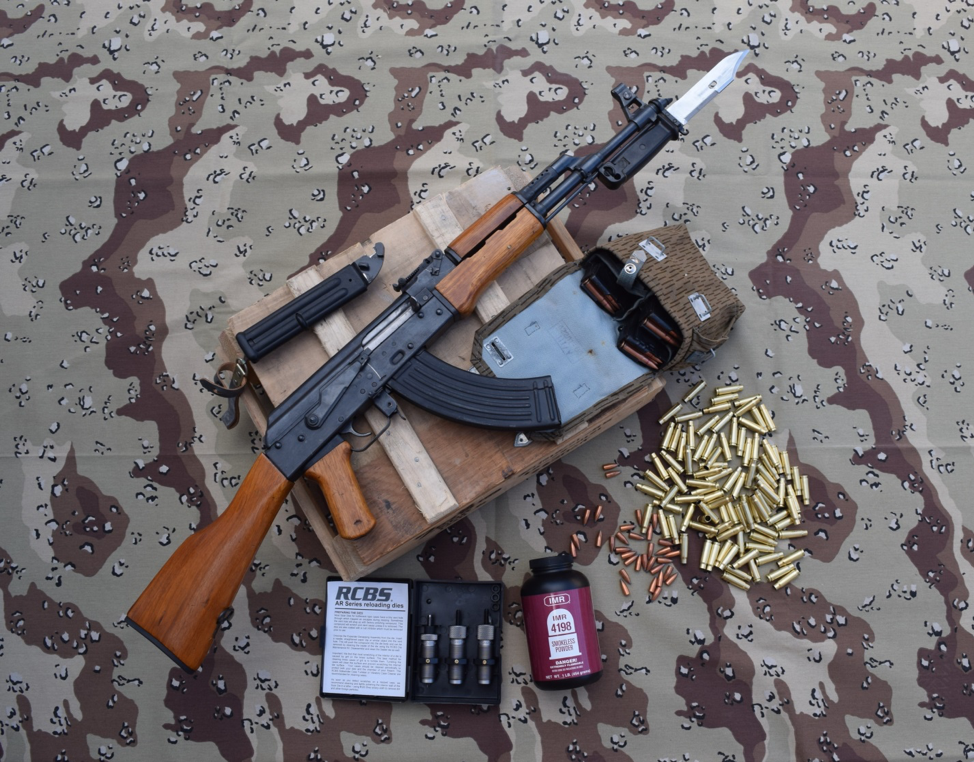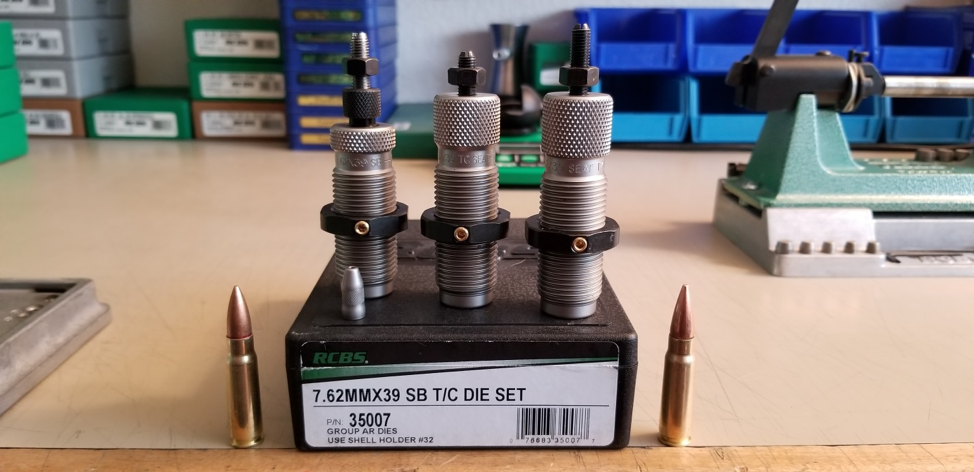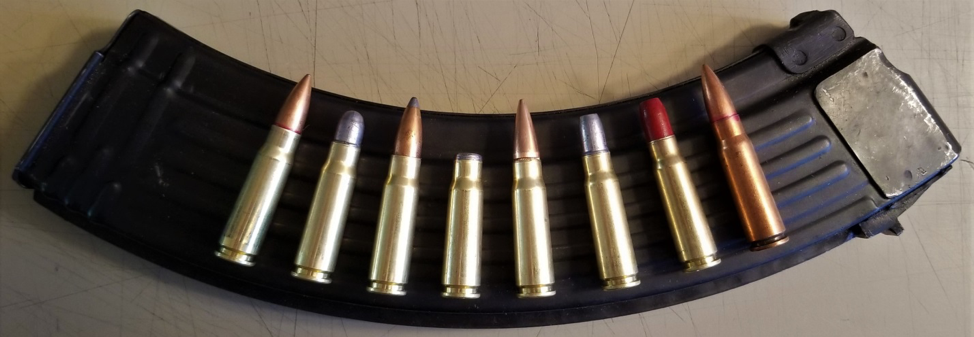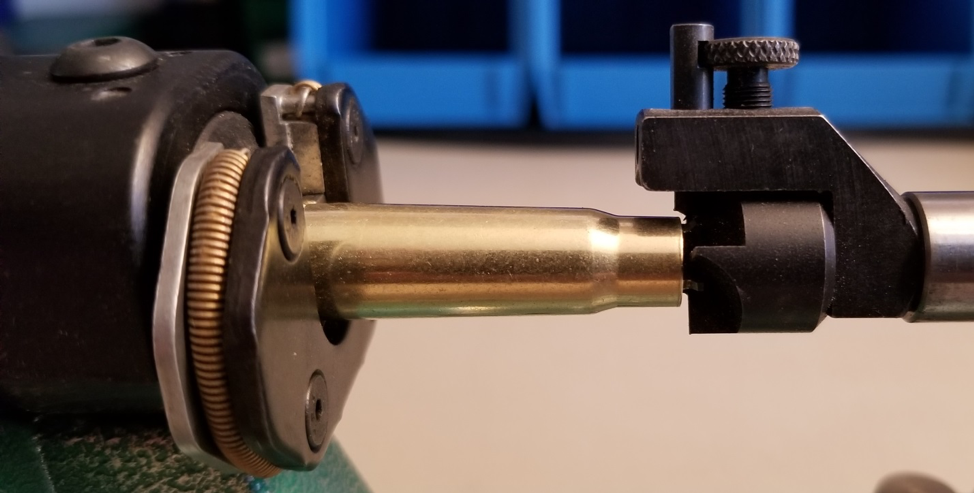

My Poly Tech International AK-47S has served me well and for over 17 years. It is the rifle I used to test all my loads for this article.
History of the 7.62x39mm
January 23, 1942, 321 miles west of Moscow, the village of Kholm Russia is encircled by the German Army. 5,500 German troops hold this position for 105 days. The German’s are fielding a new breed of self-loading rifle, the Maschinenkarabiner 42(W) or MKb42 developed by Carl Walther. It fires the 7.92x33mm Kurz (short) at a velocity of 2,450 ft/sec from a 30-round magazine and has a cyclic rate of 600rpm.
Between three to five thousand rifles are said to have been sent to the eastern front as part of the German rifle trials. Besides the trusted k98 Mauser, the German Army fielded many firearms capable of full automatic fire. The Russian Army also fielded some semi and full automatic arms, but the bulk of the Russian infantry was still using the battle proven M1891 Mosin-Nagant chambered in 7.62x54R (Russian). The Nagant had a muzzle velocity of 2,650 ft/sec and fired from a 5-round integral box magazine.
It’s been alleged that the Russian high command was more than interested in the German’s 7.92 Kurz and soon started developing their own version and the rifle to chamber it. In 1943, the Russian Technical Council of the People's Commissariat for Armaments soon developed their own intermediate range cartridge—the 7.62x39mm.
After its introduction, it would soon be paired up with the newest rifle in the Russian arsenal, the SKS-45 (Samozaryadny Karabin sistemy Simonova) designed in 1943 by Sergei Gavrilovich Simonov. The SKS saw service with front line Russian troops till the early 1950s with an estimated 2.7 million rifles manufactured. About that time, a Russian small arms designer by the name of Mikhail Timofeyevich Kalashnikov was making history, although he didn’t quite know it at the time. After years of work, Kalashnikov’s labors were rewarded and in 1948, the 7.62x39mm cartridge was being fired from his Avtomát Kaláshnikova Model 1947 and placed in service with the Russian military.
The AK-47 is without a doubt, the most manufactured rifle in the world. Over 121 countries either manufacture and or field some variant of this rifle. It’s considered so significant in Mozambique that their flag includes the image of an AK-47 with a fixed bayonet. It’s estimated that over 175 million AK-47 rifles and its variants have been manufactured to date, but with new rifles being manufactured every day, I’m sure this number is significantly higher.
There has always been a dispute between the cartridge and the rifle that fires it. Many believe its dependability is unquestionable, but its inaccuracy at ranges past 300 yards continues to be debated. The 7.62x39mm also carries the scrutiny of being considered an underpowered cartridge because of its short case. One fact that should never be contested is how many people have met their demise from the business end of this underpowered cartridge, fired from this inaccurate rifle.
Reloading the 7.62x39mm
Ok, you’re ready to reload all the free brass you collected at the range. The first of three issues you’ll experience is most imported ammunition isn’t brass at all; it’s steel and therefore not reloadable. Use a magnet to sort through your spoils and separate everything that sticks and scrap it. Secondly, even if it’s brass, it may be Berdan-primed, reloadable, yes, easy, no, unless you really love a good reloading challenge! And third, some companies manufacture their brass with either small or large primer pockets, this will require you to sort brass for obvious reasons. This is a personal choice as to which size you use. Starline uses large rifle primers, ergo, so do I and on average you get more than 100 feet per second more from large primers, the chronograph doesn’t lie. There’s no harm in breathing new life into free brass if you have the time to sort out the undesirables, but this will undoubtedly cause a delay in your ammo production. I personally would rather be filling an ammo can with ammunition I know is made from new reloadable brass.
After you have purchased your desired amount of Starline brass, the bullets you're loading will be dictated by the rifle you’re loading it for. Let’s say you own a Ruger Mini Thirty that was manufactured during or before 1992, .308” diameter bullets will do nicely as that’s the bore diameter the barrels were manufactured for. After 1992, they switched to a barrel that used utilized the .311/.312 bullets, employing a 1-10-inch right-hand twist. Military rifles such as the SKS and AK-47 tend to be .311” diameter. If you’re not sure or unable to find the bore diameter information, here’s how you find it. Purchase an ingot of Cerro safe chamber casting alloy from Brownell’s and follow the simple instructions, measure your bore cast with a caliper and the diameter mystery will be resolved. If it’s a modern rifle, you may find the bore diameter in the instruction manual or on the manufacturer’s website. What about customer service you ask? Keep in mind, most firearms manufacturers discourage or downright forbid you from using hand loads or reloads for liability reasons.
You can safely fire .311” bullets out of a .308 diameter bore if necessary, but it is more suitable for those with an advanced degree in hand loading. This technique may be especially useful if you have a .308 caliber rifle with a shot out bore. The larger diameter bullets will fill in the gap of missing bore material and in some cases makes the rifle serviceable and more accurate once again. This saves you from having to pay the gunsmith or purchase a new rifle.
If you are hunting or target shooting and accuracy is a necessity, then sweat the details and work up an accurate load for the barrel diameter you’re using. Keep in mind that regular and full-length rifle dies may not size the brass so it will fit or function in tight-chambered semi-automatics, pump action and lever-action rifles. Small base dies resize cases below SAAMI minimums, reducing the shoulder and body by a few thousandths. Using a small base sizing die guarantees fit and function.


There are many types of powders used in the loading process. Some powders are flexible enough to be used in both rifles and handguns, while some shotgun powders work well in handguns. I often thought it would be great to have one powder to load them all and wouldn’t that be way less problematic? Of course, powder behavior is a learned science and all seasoned bullet stuffers have their go to powders and the loads they’ve developed from them.
The use of a chronograph will provide you with the numbers to confirm whether a load has struck accuracy gold. If you’re new, be sure to follow these simple rules. You must use the correct powder for the type of bullet you want to use in the caliber you’re loading for. New loaders should also stick with loads from published re-loading manuals and as experience grows, so will your skills and your understanding of how powders behave.
7.62x39MM BRASS SPECIFICATIONS
Maximum Case Length: 1.528
Trim-To-Length: 1.518
Max OAL (Over All Length): 2.200
RCBS Shell Holder: #32
RCBS Pilot Caliber: 30/31
RCBS Collet: 3
Primer: Large Rifle/Small Rifle
Some of the powders you can use in loading the 7.62x39mm include, but are not limited to, IMR4198, IMR4895, Reloder 7, AA1680, Viht. N120 and BL-C(2). According to the Speer loading manual #14, these powders are all safe to load and fire a .310” diameter, 123 gr., 303 Spitzer Soft Point in an AK-47. There are many published loading manuals to include Barnes, Sierra, Hornady and Speer as well as powder manufacturing websites like Hodgdon Powders.
Never exceed the maximum charge numbers unless you are a seasoned loader. Start low and work up; a half grain goes a long way in a charge of powder. Also, keep in mind that hot loads wear your rifle down faster over time. Over-pressured loads can make cases harder to resize and can stretch the primer pockets enough to make primers fall out, blow out or seat too deep. Loading lighter charges of powder can result in getting 20 or more firings out of your Starline brass.
With the AK-47 and SKS being two of the most well-known rifles in the world, most shooters purchase the cheapest fodder on the shelf, so these and other rifles in this chambering seldom achieve their full potential. Some non-AK style rifles in this chambering include the Ruger Mini 30 and Ruger American Ranch Rifle, IWI Galil Ace Rifle and SIG 556xi. These are a few examples of rifles that can be used for sporting and hunting purposes and can give you more flexibility from your 7.62x39mm loadings.
Bullet choices for this 7.62x39mm can range from .32 caliber 60 grain pistol bullets on up to 265 grain rifle bullets. Handloading gives you the potential for creating loads that can be used for varmints, medium game hunting and affordable target practice. This of course involves a more advanced working knowledge of powder and bullet combinations, so care should be taken when loading something you’re not familiar with. It is rare to find loading information in a manual for anything but the norm, so I consulted with my mentor Bob Shell to create loads for this article involving some specialized loads you won’t find in any book. I handloaded 100 gr. wad cutters, 125 gr. cast bullets, 150 gr. soft points and 265 gr. Hi-Tek coated flat points as well as some normal 122 gr. .311” and 150 gr. .308” FMJ loads.

Here is a bit of friendly advice from someone who’s made these beginner’s mistakes. Load 10-15 rounds and shoot them through your rifle to make sure they function flawlessly. If you’re chronographing, this will allow you to perform both functions. If they are unsatisfactory or unsafe, shoot the rest (again if safe to do so) or pull the bullets and record that load under the (BAD LOAD) column in your personal reloading data book. This keeps you from having to pull 20, 50 or 100 bullets. It’s not a fun job; been there done that.
Another tip is to chamber check your loads at home. Chamber checkers are sold by Midway and Brownell’s. In a pinch, you must (REMOVE) your rifle bolt or disassemble your handgun and drop it in the barrel’s chamber. If it sticks, use a cleaning rod to gently push or tap it out and figure out what went wrong. A correctly sized load should easily chamber and fall free when the rifle or pistol barrel is turned upside down. OAL (Over All Length) is especially important when it comes to chambers and firearms magazines. If the cartridge is too long, it will not allow you to fully chamber the round and will not lock up, jam the magazine, or both. Chamber check handloads and reloads during other range activities and avoid function checking live rounds inside your home. Bad things happen, police are called, and handcuffs are applied.
Finding out you have an issue with your loads at home enables you to make corrections, which is next to impossible in the field. Unless you carry a reloading press in your vehicle; something I’ve only seen once in my 43 years of shooting.
There is a bit of contention between the term Handloading and Reloading. Here’s my simple explanation. Handloading is the assembly of new components to manufacture a round of ammunition for the purposes of competition or hunting. Reloading is the process of using your spent range brass to re-manufacture the same or similar round of ammunition. Either way you look at it, you’re accomplishing the same end goal.
So, what happens after the initial firing? Clean your brass using a case tumbler. I prefer Dillon’s CV-2001 Vibratory Case Cleaner and CM-2000 Case/Media Separator because of their large capacities. This makes cleaning, media separation and inspection easier and keeps the dirt from damaging the inside of your dies. Another great brass processing aid is the Dillon Shell Sorting Pans. Simply place on any 5-gallon bucket, shake your pans one at a time starting from the top and your brass is sorted by caliber. Inspect brass for cracks. Small dents are fine as they will fire form (Using the explosion inside the chamber to push out the dents) out on the next firing. Then resize and de-prime your cases and move to the next step.
After inspection, check whether the fired brass is within reloadable length specifications. Use a Lyman E-ZEE Case Length Gauge or for more precise measuring, a RCBS Dial Caliper/Case Length Gauge. If they are too long and need trimming, just set the trim length on your RCBS Trip Pro 2 case trimmer, equipped with an RCBS .30 Caliber Trim Pro Three Way Cutter and remove the excess so the trim to length measurement is achieved. If it’s within spec, the cutter will not remove any brass. Simply move on to the next case.

A trimming hack I’ve developed is taking a new or used case and trimming it to its specified Trim-to length, 1.518 for a 7.62x39. Use a P-touch labeling machine or sharpie to mark the caliber and TTL. Next time you trim that caliber, just use that case to quickly set up your trimmer. This is a basic explanation of the process. If you have any questions or doubts on what you want to accomplish, ask an experienced loader or call RCBS at 800-379-1732. A representative will be available to answer your calls between 7 a.m. – 4:30 p.m. PST Monday through Friday.
If you want to read more on the loading process, visit the RCBS or Hodgdon websites for cartridge loading videos and instruction. Or, if you’re technically challenged, simply read your reloading manual. They all walk you through the simple steps of reloading and contain a section that familiarizes you with reloading jargon.
http://rcbs.com/Resources/Introduction-to-Handloading/Handloading-Basics.aspx
http://www.hodgdonreloading.com/reloading-education
HAND LOAD CHRONOGRAPH RESULTS | PTI AK-47S | 7.62X39MM
| BULLET WT. / MANUFACTURER: | POWDER: | AV:(FPS) | SD: |
| 122gr. .311” Pulled Bullets / Chinese Made | 25gr. IMR4198 | 2369.1 | 27.9 |
| 125gr. .311” Cast Round Nose | 18gr. 5744 | 1760.1 | 31.2 |
| 150gr. .311” Sierra Soft Point | 21.7gr. 1680 | 2020.8 | 24.3 |
| 100gr. .308” Cast Wad Cutters | 6gr. Unique | 1418.1 | 27.4 |
| 150gr. .308” Hornady FMJ Boat Tail | 22.1gr. IMR4198 | 2011 | 31.0 |
| 165gr. .308” Cast Flat Point | 10gr. Unique | 1397.4 | 20.2 |
| 265gr. .308” Hi-Tek Coated (Used for 300AAC) | 7gr. Unique | 904.3 | 9.2 |
Notes: Velocities figures are derived from a ten-round average recorded on a Caldwell Ballistic Precision Chronograph G2 placed 15 feet from the muzzle. Velocities will vary for each loading depending on factors such as bullets, powder and primers used. Abbreviations:(AV): Average Velocity of all ten rounds fired through the chronograph (Standard Deviation): The lower the SD, the better the accuracy/performance with that load and firearm combination.
I’ve always enjoyed passing on the knowledge I’ve learned. I’m still learning something new every day I sit behind my press. But there are some lessons in the loading process you must FEEL for yourself that books and the web can’t explain. Hands on is always your best teacher.
The advantage you as a loader have in this high-tech world is the information is literally right at your fingertips, as is the history of this iconic firearm and cartridge. Starline Brass produces high quality brass and their 7.62x39mm brass is no exception. It comes ready to accept your .311” diameter bullets and it’s offered in quantities of 250, 500 or 1000 pieces.
Starline carries standard caliber brass as well as some unique and hard to find offerings, so after you finish reading this article, be sure to browse their inventory and see if they have the brass you’re looking for. Here are some of their new calibers recently released; the 224 Valkyrie (Small Rifle primer), SR 6mm CM (Small Rifle primer), .308 Match (Small Rifle primer), and 455 Webley MKII (Large Pistol primer).
Contributors:
Starline Brass: (660) 826-6640 www.starlinebrass.com
RCBS: (800) 379-1732 www.rcbs.com
Hodgdon Powders: (913) 362-9455 www.hodgdonreloading.com
Caldwell: (877) 509-9160 www.btibrands.com
Bob Shell: Shell Reloading rel4350@aol.com
DISCLAIMER: All reloading data in this article is for informational purposes only. Starline Brass and the author accept no responsibility for use of the data in this article.